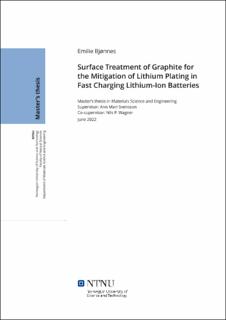| dc.description.abstract | Grafittanoden har vært det foretrukne valget for bruk i litium-ionbatterier (LIB-er) siden de ble kommersialisert i 1991, på grunn av dens lave kostnad, råmaterialtilgjengelighet, relativt høye energi- og effekttetthet og lange syklingsliv. Imidlertid utgjør forekomsten av litium (Li)-plettering på anodeoverflaten ved hurtiglading en sikkerhets- og degraderingsrisiko for LIB-er. Grunnen til dette er at vekst av dendritter av belagt Li-metall kan punktere separatoren og forårsake kortslutning og brann i batteriet. Derfor må grafittanoden utvikles med søkelys på dens evne til å redusere Li-plettering, ettersom forbedringen av hurtigladeevnen til LIB-er spiller en avgjørende rolle i å elektrifisere transportsektoren.
Denne oppgaven undersøker effekten av å overflatebehandle grafittpartikler for å begrense Li-plettering ved å sammenligne to syntetiske grafittpulver, dvs. et ubehandlet og et overflatemodifisert med amorft karbonbelegg. Halvceller med Li-metall som motelektrode ble elektrokjemisk testet for å undersøke effekten av Li-plettering og evnen til grafittpulveret til å begrense Li-plettering. Li-metall ble bevisst plettert ved å litiere grafittelektroden under 0 V vs. Li/Li$^+$. Mengden reversibel og irreversibel plettering ble kvantifisert ved å analysere potensial- og differensialkapasitetsplott etter at Li-plettering ble pålagt ved 50\% og 100\% oppladning. Resultatene samsvarte med litteraturen, nemlig at risikoen for plettering øker med økt oppladning på grunn av den økte motstanden mot litiering for økte konsentrasjoner av Li i grafittstrukturen. Videre reduserte de overflatemodifiserte grafittpartiklene Li-pletteringen i større grad i begge tilfellene, ettersom mindre plettering ble kvantifisert for de modifiserte cellene enn for de ubehandlede cellene. I tillegg ble det irreversible førstesykel kapasitetstapet redusert for de modifiserte cellene, noe som resulterte i et tynnere overflatesjikt mellom grafittanoden og elektrolytten (SEI). Dette var knyttet til den reduserte overflateruheten til det modifiserte pulveret.
Syklisk voltammetrimålinger bekreftet den mer gunstige cellekinetikken til den modifiserte cellen, da litieringen og delitieringen skjedde ved henholdsvis høyere og lavere potensialer sammenlignet med for den ubehandlede cellen. Impedansmålinger utført før og etter Li-plettering viste at den totale elektrodemotstanden var lavere og det indre aktive elektrodearealet, avledet fra kapasitansen, var større for den modifiserte cellen. Disse funnene støtter teorien om hvordan et amorft karbonbelegg resulterer i en jevnere overflate som reduserer motstanden mot desolvasjon av Li-ioner på anodeoverflaten, og på denne måten kan anses som en sentral faktor for å redusere Li-plettering.
For å oppdage eventuell gjenværende Li-plettering og mulig degradering, ble post mortem skanning elektronmikroskopi med sekundære og tilbakespredte elektroner brukt. Effekten av pletteringsstrømmen var synlig ved påvisning av to forskjellige pletteringsstrukturer, dvs. tykke dendritter for høye C-rater og en moseliknende og mer porøs struktur for lave C-rater. Sistnevnte struktur kan bidra til høyere irreversibel plettering og økt risiko for elektrolyttreduksjon, og bør undersøkes nærmere.
Alt i alt viser funnene at overflatebehandlingen av grafitt med amorft karbonbelegg reduserer risikoen for Li-plettering og dermed forbedrer grafittanodens hurtigladingsevne. | |
| dc.description.abstract | The graphite anode has been the preferred choice for use in lithium-ion batteries (LIBs) since their commercialisation in 1991, due to its low cost, raw material abundance, relatively high energy and power density, and long cycle life. However, the occurrence of lithium (Li) plating on the anode surface upon fast charging poses a safety and degradation risk to the LIB. The reason for this is that growth of dendrites of plated Li metal can puncture the separator and cause a short circuit and fire of the LIB. Thus, the graphite anode must be developed with a focus on its capability to mitigate Li plating, as the improved fast charging capability of LIBs plays a crucial role in electrifying the transportation sector.
This thesis investigates the effects of surface treatment of graphite particles on mitigation of Li plating by comparing two synthetic graphite powders, i.e. one pristine and one surface modified by amorphous carbon coating. Half cells with Li metal as the counter electrode were electrochemically tested to investigate the effect of Li plating and the mitigation capabilities of the graphite powders by deliberately imposing Li plating by lithiation of the graphite electrode below 0 V vs. Li/Li$^+$. Using potential and differential capacity plots, the amount of reversible and irreversible plating was quantified after a set amount of plating was imposed at 50\% and 100\% state of charge (SOC). The results were in agreement with the literature, namely, that the risk of plating increases with an increased SOC due to the increased resistance towards lithiation for increased concentrations of Li in the graphite structure. Furthermore, the surface modified graphite particles mitigated Li plating to a greater extent in both cases, as less plating was quantified for the modified cells than for the pristine cells. Also, the first cycle irreversible capacity loss was reduced for the modified cells, resulting in a thinner solid electrolyte interface layer. This was linked to the reduced surface roughness of the modified powder.
Cyclic voltammetry measurements confirmed the more favourable cell kinetics of the modified cell, as the lithiation and delithiation occurred at higher and lower potentials, respectively, compared to for the pristine cell. Impedance measurements performed before and after imposed Li plating revealed that the total electrode resistance was lower and the active internal surface area, derived from the capacitance, was larger for the modified cell. These findings support the theory about how amorphous carbon coating results in a smoother surface that reduces resistance towards desolvation of Li-ions on the anode surface, which is a key factor for mitigating Li plating.
In order to detect any residual Li plating and possible degradation, post mortem scanning electron microscopy using secondary and backscattered electrons was utilised. The effect of plating C-rate was visible by detection of two different plating structures, i.e. thick dendrites for high C-rates and a mossy and more porous structure for low C-rates. The latter structure may contribute to higher irreversible plating and an increased risk of electrolyte depletion, and should be examined further.
Overall, the findings show that the surface treatment of graphite with amorphous carbon coating mitigates the risk of Li plating and improves the fast charging capability of the graphite anode. | |
